 |
 |
 |
| |
Efficacy and Safety by Baseline HIV RNA and CD4 Count in Treatment-Naïve Patients Treated With Atazanavir/RTV and Lopinavir/RTV in the CASTLE Study
|
| |
| |
Reported by Jules Levin
9th International Congress on Drug Therapy in HIV Infection, Glasgow, UK, 9-13 November 2008
J. Uy,1 R. Yang,2 A. Thiry,2 J. Absalon,2 A. Farajallah,1 J. Maa,1 and D. McGrath2 for the CASTLE Study Group
1Bristol-Myers Squibb, Plainsboro, NJ, USA; 2Bristol-Myers Squibb, Wallingford, CT, USA
AUTHOR CONCLUSIONS
This subgroup analysis of CASTLE confirms that ATV/RTV is an effective and well-tolerated once-daily treatment that is appropriate for use in HIV-infected treatment-naïve patients, including individuals with high viral loads and low CD4 cell counts.
ATV/RTV demonstrated similar antiviral efficacy to LPV/RTV, irrespective of baseline HIV RNA strata.
-- Although response rates decreased with increasing baseline HIV RNA, this occurred to a similar extent in both treatment groups.
For ATV/RTV, virologic response rates remained consistent across baseline CD4 strata. In contrast, for LPV/RTV, lower baseline CD4 cell counts were associated with lower response rates in the ITT analysis.
In the lowest CD4 cell count stratum (CD4 < 50 cells/mm3), discontinuations from LPV/RTV were over twice the rate of discontinuations from ATV/RTV through Week 48.
Both regimens were associated with robust increases in CD4 cell count, regardless of baseline HIV RNA or CD4 count strata.
Treatment-related AEs, particularly nausea and diarrhea, were more commonly observed in LPV/RTV patients with lowest baseline CD4 counts (< 50 cells/mm3) compared with patients on ATV/RTV.
Introduction
--Atazanavir (ATV) is a potent, well-tolerated, once-daily HIV-1 protease inhibitor (PI) with established efficacy in both treatment-naïve and treatment-experienced patients.1,2
--The CASTLE study was an international, randomized, open-label, prospective study comparing the efficacy and safety of ATV/ritonavir (RTV) with that of lopinavir (LPV)/RTV (both given in combination with tenofovir/emtricitabine [TDF/FTC]) in treatment-naïve patients.
--In the 48-week analysis of CASTLE, the ATV/RTV-based regimen was shown to be noninferior in antiviral efficacy to the LPV/RTV-based regimen with less gastrointestinal (GI) toxicity, and a better lipid profile.3
--In a prespecified analysis, there was a diminution in response rates in patients with high baseline HIV RNA levels (> 100,000 copies/mL vs ≦ 100,000 copies/mL) in both treatment arms.3
--In a post hoc test of a prespecified analysis, low baseline CD4 cell counts were associated with reduced virologic response rates for the LPV/RTV-based regimen but not for the ATV/RTV-based regimen.3
--Evidence of reduced virologic response to LPV/RTV in treatment-naïve patients with qualifying CD4 cell counts < 50 cells/mm3 has been previously reported in comparative studies versus darunavir4 and nelfinavir,5 but this association was not detected in other LPV/RTV studies.6,7
Objective
--To explore the impact of baseline HIV RNA and CD4 cell count on the virologic, immunologic, and safety profiles of ATV/RTV and LPV/RTV (both in combination with TDF/FTC) in treatment-naïve HIV-infected patients.
Methods
--CASTLE was a randomized, open-label, prospective study comparing once-daily ATV/RTV (300/100 mg qd [n = 440]) with twice-daily LPV/RTV (400/100 mg qd [n =443]), both in combination with fixed-dose TDF/FTC (300/200 mg qd) in 883 antiretroviral therapy (ART)-naïve HIV-infected patients.
--Patients were stratified according to HIV RNA < 100,000 copies/mL or ≥ 100,000 copies/mL and geographic region.
--The primary end point was the proportion of patients with HIV RNA < 50 copies/mL at Week 48.
--Secondary assessments included CD4 cell count change and safety parameters (adverse events [AEs] and laboratory tests [eg, serum chemistry and hematology, fasting lipid profile]).
--Prespecified subgroup analyses to assess the impact of baseline HIV RNA and CD4 cell count on virologic response and changes in CD4 cell count were performed according to the following strata:
HIV RNA (copies/mL): < 100,000; 100,000 - < 500,000; ≥ 500,000.
CD4 count (cells/mm3): < 50; 50 - < 100; 100 - < 200; ≥ 200.
--Prespecified subgroup analyses to assess the impact of baseline HIV RNA and CD4 cell count together on virologic response were performed by CD4 count (cells/mm3) < 100 and ≥ 100 and HIV RNA (copies/mL) < 100,000 and ≥ 100,000.
--Post hoc subgroup analyses to assess impact of baseline HIV RNA and CD4 cell count on safety parameters were performed according to the same strata.
RESULTS
Patient Demographics and Disposition
Patient characteristics at baseline are summarized by baseline HIV RNA and CD4 cell count in Tables 1 and 2.
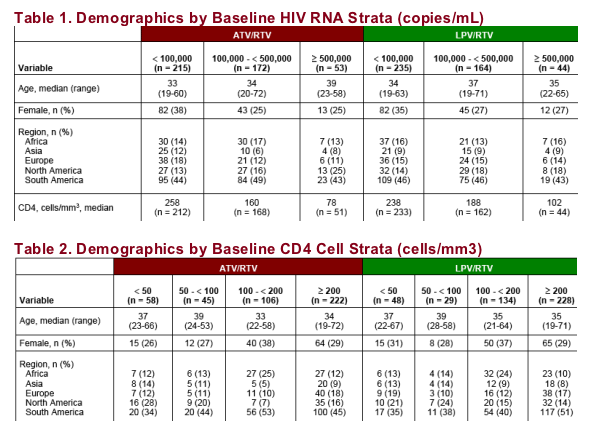
Virologic and Immunologic Responses
In the entire population, 78% of patients receiving ATV/RTV and 76% of patients receiving LPV/RTV achieved a confirmed virologic response (CVR) (HIV RNA < 50 copies/mL, intent-to-treat [ITT]) at Week 48 (difference estimate 1.7% [95% CI, -3.8% to 7.1%]).
Analyses of CVR according to CD4 cell count and HIV RNA strata at baseline are summarized in Figure 1A and B.
In the ITT analysis, reduced virologic response rates were observed in the LPV/RTV arm for patients with lower baseline CD4 cell counts (P = 0.0085); in the ATV/RTV arm response rates were maintained across the baseline CD4 strata (Figure 1A).
Response rates in patients with baseline CD4 counts < 50 cells/mm3 were 78% for ATV/RTV compared with 63% for LPV/RTV (CVR, ITT analysis). Variation in response rates across the baseline CD4 strata in the LPV/RTV arm was diminished in analysis of the data on an as-treated basis (CVR, noncompleter = missing) (Figure 1B).
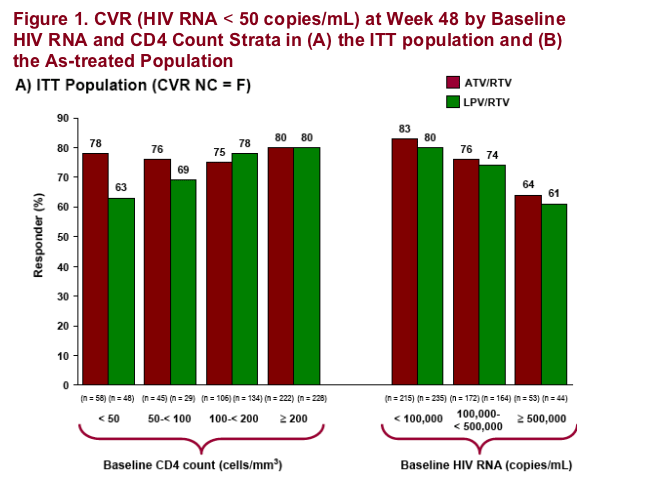
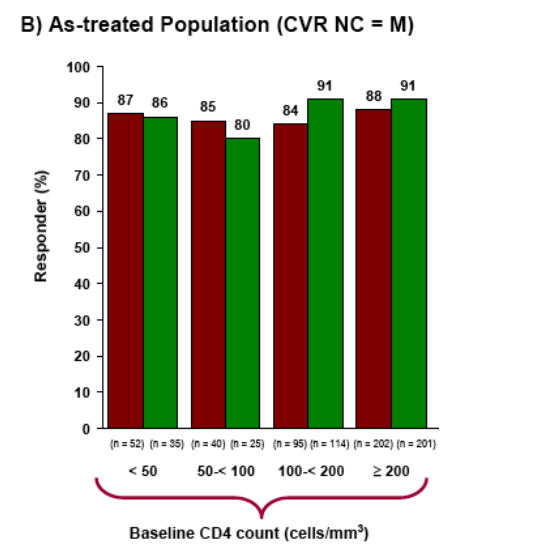
In both analyses, virologic response rates decreased to a similar extent across treatment groups with increasing baseline HIV RNA (Figure 1).
In patients with HIV RNA ≥ 500,000 copies/mL, 34/53 (64%) on ATV/RTV and 27/44 (61%) on LPV/RTV achieved HIV RNA < 50 copies/mL (CVR, ITT).
In patients with both baseline CD4 < 100 cells/mm3 and HIV RNA ≥ 100,000 copies/mL, 60/83 (72%) on ATV/RTV and 40/64 (63%) on LPV/RTV achieved HIV RNA < 50 copies/mL (CVR, ITT).
Discontinuations and virologic failures based on CVR treatment outcomes are summarized in Table 3. In patients with baseline CD4 < 50, 6/58 (10%) on ATV/RTV and 12/48 (25%) on LPV/RTV discontinued from the study through Week 48.
Analyses of mean change in CD4 cell count according to baseline HIV RNA strata and CD4 count strata are summarized in Table 4.
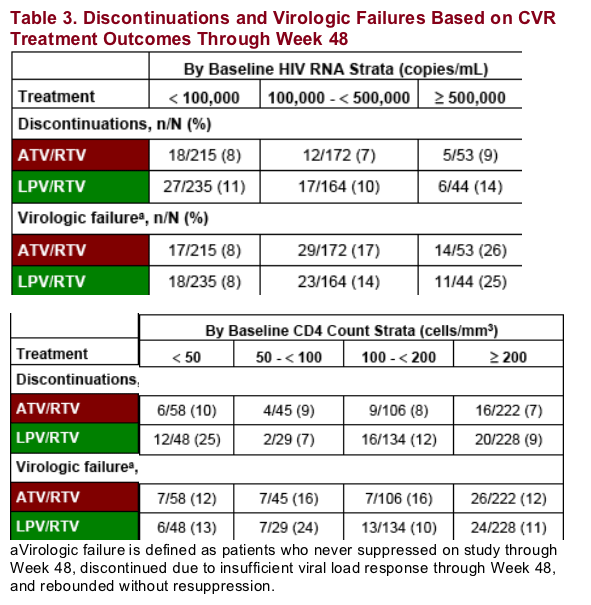
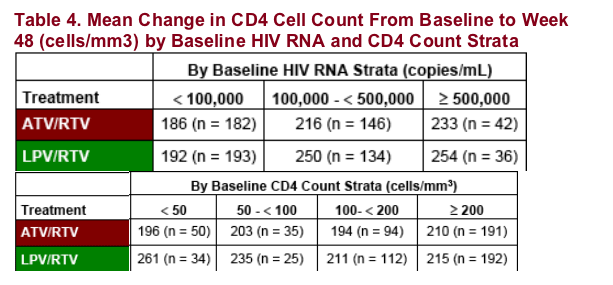
Tolerability and Safety
In most cases, AEs were not treatment-limiting.
The incidence of all treatment-related grade 2 to 4 AEs and of selected grade 2 to 4 treatment-related AEs of clinical interest through Week 48 are summarized in Table 5 by baseline HIV RNA strata and baseline CD4 cell count strata.
A higher incidence of grade 2 to 4 treatment-related AEs (most notably diarrhea and nausea) was observed with LPV/RTV at low baseline CD4 cell counts (40% with LPV/RTV compared with 20% for ATV/RTV in patients with baseline CD4 counts < 50 cells/mm3).
The AE profiles for both ATV/RTV and LPV/RTV were consistent across the baseline HIV RNA strata.
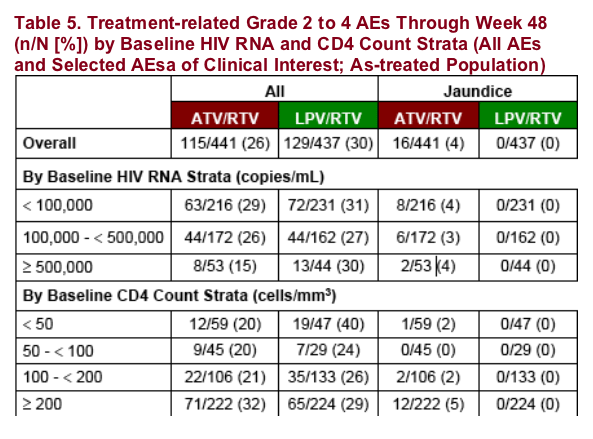
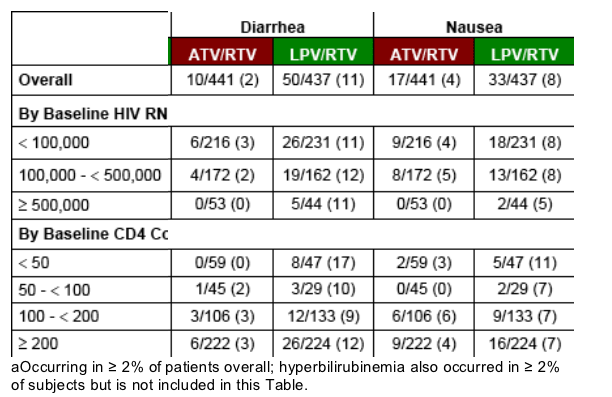
REFERENCES
1. Johnson M, et al. AIDS. 2006;20(5):711-8.
2. Malan DR, et al. J Acquir Immune Defic Syndr. 2008;47(2):161-7.
3. Molina J-M, et al. Lancet. 2008;372(9639):646-55.
4. Ortiz R, et al. AIDS. 2008;22(12):1389-97.
5. King MS, et al. J Infect Dis. 2004;190(2):280-4.
6. Smith K, et al. Presented at: 15th Conference on Retrovirus and Opportunistic Infections (CROI); February 3-6, 2008; Boston, MA.
7. Gathe J, et al. Presented at: 15th Conference on Retrovirus and Opportunistic Infections (CROI); February 3-6, 2008; Boston, MA.
|
| |
|
 |
 |
|
|